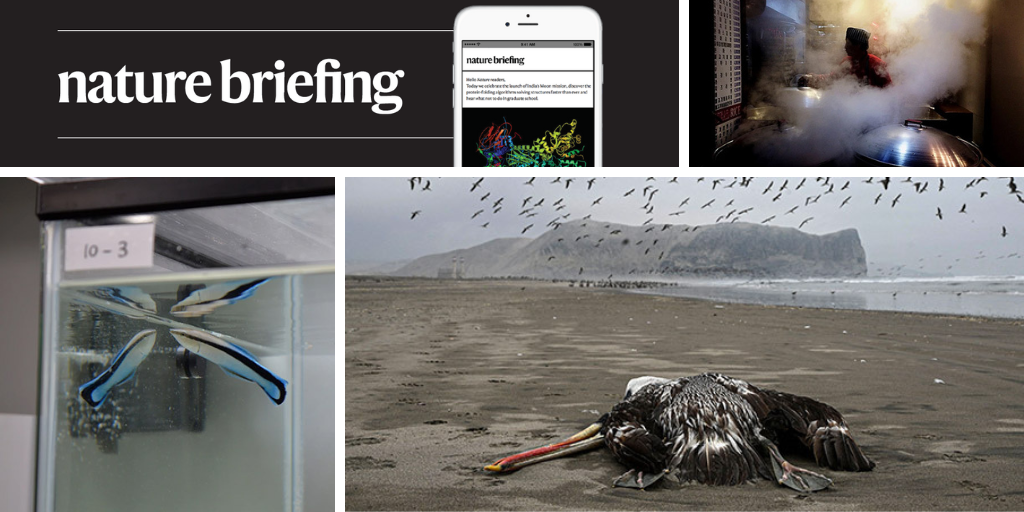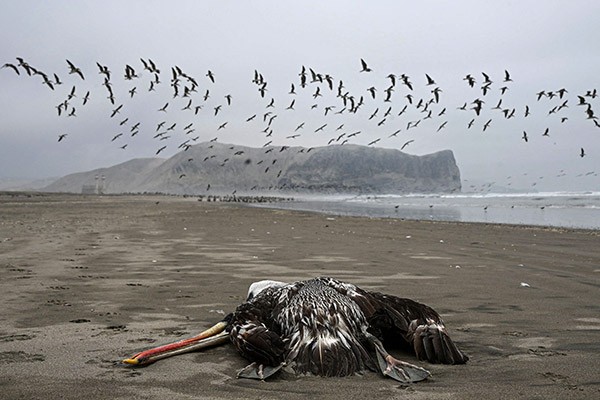Hello Nature readers, would you like to get this Briefing in your inbox free every day? Sign up here
A pelican, suspected to have died from H5N1 avian influenza, is seen on a beach in Lima on 1 December 2022. The highly contagious H5N1 avian flu virus has killed thousands of pelicans, blue-footed boobies and other seabirds in Peru, according to the country’s National Forestry and Wildlife Service. (ERNESTO BENAVIDES/AFP via Getty)
An outbreak of the H5N1 influenza virus in mink, reported in January, has ramped up long-standing fears about how far ‘bird flu’ might spread. Serious concerns about a human pandemic were triggered by a bird-flu outbreak in Hong Kong in 1997, when it killed six people. But the virus seems to ebb and flow, making it unpredictable — and worrying. It is already ravaging populations of wild birds and becoming a major problem for the agricultural industry. And scientists say that the world’s poor response to the COVID-19 pandemic suggests that whatever happens, we’re not ready for it.
Read more: Bird flu outbreak in mink sparks concern about spread in people (Nature | 4 min read, from January)
Mining Moon dust and shooting it into space could deflect just enough sunlight to stave off the worst of global warming, theorize three astrophysicists. A 10-billion-kilogram dust cloud in space, invisible to people on the ground, would block the equivalent of about six days of sunlight on Earth each year. The dust would be pushed out of position within a week, so regular top-ups would be required. Scientists have called this ‘moonshot’ idea “quite irresponsible” and “fun, scientifically interesting speculation” that is unlikely to be put into practice.
The Washington Post | 8 min read & The Guardian | 4 min read
Reference: PLoS Climate paper
The bluestreak cleaner wrasse (Labroides dimidiatus) seems to recognize its own face — an indication of self-awareness that has so far been found only in humans and a few other species. Each fish was shown composite images: its own head photoshopped onto another fish’s body, and its own body with another fish’s head. The fish were less aggressive towards their own faces, even on another fish’s body, suggesting that this fish forms a mental image of its countenance.
A bluestreak cleaner wrasse looks at its reflection in a mirror.Credit: Taiga Kobayashi
Features & opinion
Indoor air pollution kills almost as many people as toxic air outdoors — more than three million in 2020, according to the World Health Organization — but hasn’t faced the same scrutiny. If you’re reading this, you probably spend most of your time indoors, where carbon monoxide, mould spores, cancer-causing fumes, particulates and respiratory pathogens can build up. Such diversity makes it challenging to define what good indoor air quality looks like and how best to achieve it. It’s time for science to step up, argue atmospheric chemist Alastair Lewis, public-health physician Deborah Jenkins and Christopher Whitty, the UK government’s chief medical adviser.
What’s the best way to handle research projects that dance along the edge of viability? Four researchers offer tips, including pausing or redefining a project rather than ending it, and using your professional circles to acquire skills that might help to get a stagnant project going again. Importantly, stay open-minded about exploring options, and learn to let go: “Many academic researchers are emotionally invested in their projects, which is great — you want to love doing what you do, but there is a fine balance between being persistent and being stubborn,” says biomedical engineer Dragana Savic.
Scientists are grappling with the language used to describe autism. Some researchers say calling autism a ‘disorder’ or ‘disease’ — instead of a difference or neurodivergence — dehumanizes autistic people. Others counter that not being able to use words such as ‘symptoms’ and ‘comorbidities’ stifles scientific progress and downplays the experience of some autistic people. “Why not just be specific?” asks psychologist Monique Botha, who is autistic. “Specificity is always going to be more rigorous and accurate than generalization.”
Regular readers know that our favourite penguin, Leif Penguinson, can hide almost anywhere. The newly discovered Kumimanu fordycei, the largest penguin that ever lived, might have had a harder time of it. It weighed around 155 kilograms — more than all but the heaviest pandas. (The largest penguin species living today, the emperor (Aptenodytes forsteri), averages around 35 kilograms.) Being a big chonky boi has its advantages, says palaeontologist Daniel Ksepka. “If you’re a little one-pound penguin, a gull can just rip your head off,” he says. “But a 300-pound penguin is not going to worry about a sea gull landing near it because it would just crush it.” Kumimanu fordycei is one of nine new penguin specimens from the late Paleocene described in a new paper, and it’s unlikely to be beaten on bigness: scientists think it is close to the upper size limit of a flightless seabird.
Thanks for reading,
Flora Graham, senior editor, Nature Briefing
With contributions by Katrina Krämer and Dyani Lewis
We’ve recently launched two new e-mails you might like. They’re free, and of course you can unsubscribe at any time.
• Nature Briefing: Cancer — a new weekly newsletter written with cancer researchers in mind. Sign up here to receive the next one.
• Nature Briefing: Translational Research covers biotechnology, drug discovery and pharma. Sign up here to get it free in your inbox each week.







More News
Daily briefing: Why exercise is good for us
Daily briefing: Orangutan is first wild animal seen using medicinal plant
Old electric-vehicle batteries can find new purpose — on the grid